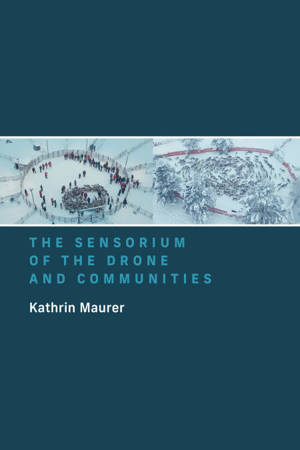
- Afhalen na 1 uur in een winkel met voorraad
- Gratis thuislevering in België vanaf € 30
- Ruim aanbod met 7 miljoen producten
- Afhalen na 1 uur in een winkel met voorraad
- Gratis thuislevering in België vanaf € 30
- Ruim aanbod met 7 miljoen producten
Zoeken
€ 44,35
+ 44 punten
Omschrijving
A comprehensive overview of how civilian drones sense the world and how they build the aesthetic imaginaries of our communities.
Drone technology has garnered critical attention across many fields, from engineering to the humanities. While the first wave of drone scholarship was key in initiating the debate on drones, it also privileged the idea of the “scopic regime”—a militarized regime of hypervisuality—in its analyses of the connection between vision and power. The Sensorium of the Drone and Communities broadens the drone’s spectrum of perception by acknowledging its creative, life-affirming possibility with the notion of the sensorium. The sensorium of the drone is a multimedia, synesthetic sensing assemblage in which the human agent is enmeshed with the drone. Drone sensoria can sense in many more ways than the scopic regime—with sound, touch, smell, temperature, and movement.
In The Sensorium of the Drone and Communities, Kathrin Maurer shows how drone sensoria can change our understanding of human communities by constructing imaginaries of social communities based on decentralized and fluid sensing processes. Maurer takes an aesthetic approach to technology, working with two understandings of aesthetics. One understanding refers to aesthetics as a way of experiencing, and it explores how the drone-human assemblage perceives the world. The other refers to aesthetic mimetic representation, and focuses on how aesthetic drone imaginaries in literature, popular culture, visual arts, and films negotiate the sensorial technology of the drone.
Bringing together key ideas in technology studies, studies of aerial views, visual and aesthetic studies, posthuman sensing, machine–human interaction, and communities, The Sensorium of the Drone and Communities sheds a welcome and necessary light on this technology’s creative potential as well as its dangers and risks.
Drone technology has garnered critical attention across many fields, from engineering to the humanities. While the first wave of drone scholarship was key in initiating the debate on drones, it also privileged the idea of the “scopic regime”—a militarized regime of hypervisuality—in its analyses of the connection between vision and power. The Sensorium of the Drone and Communities broadens the drone’s spectrum of perception by acknowledging its creative, life-affirming possibility with the notion of the sensorium. The sensorium of the drone is a multimedia, synesthetic sensing assemblage in which the human agent is enmeshed with the drone. Drone sensoria can sense in many more ways than the scopic regime—with sound, touch, smell, temperature, and movement.
In The Sensorium of the Drone and Communities, Kathrin Maurer shows how drone sensoria can change our understanding of human communities by constructing imaginaries of social communities based on decentralized and fluid sensing processes. Maurer takes an aesthetic approach to technology, working with two understandings of aesthetics. One understanding refers to aesthetics as a way of experiencing, and it explores how the drone-human assemblage perceives the world. The other refers to aesthetic mimetic representation, and focuses on how aesthetic drone imaginaries in literature, popular culture, visual arts, and films negotiate the sensorial technology of the drone.
Bringing together key ideas in technology studies, studies of aerial views, visual and aesthetic studies, posthuman sensing, machine–human interaction, and communities, The Sensorium of the Drone and Communities sheds a welcome and necessary light on this technology’s creative potential as well as its dangers and risks.
Specificaties
Betrokkenen
- Auteur(s):
- Uitgeverij:
Inhoud
- Aantal bladzijden:
- 304
- Taal:
- Engels
Eigenschappen
- Productcode (EAN):
- 9780262374897
- Verschijningsdatum:
- 2/10/2023
- Uitvoering:
- E-book
- Beveiligd met:
- Adobe DRM
- Formaat:
- ePub

Alleen bij Standaard Boekhandel
+ 44 punten op je klantenkaart van Standaard Boekhandel
Beoordelingen
We publiceren alleen reviews die voldoen aan de voorwaarden voor reviews. Bekijk onze voorwaarden voor reviews.








